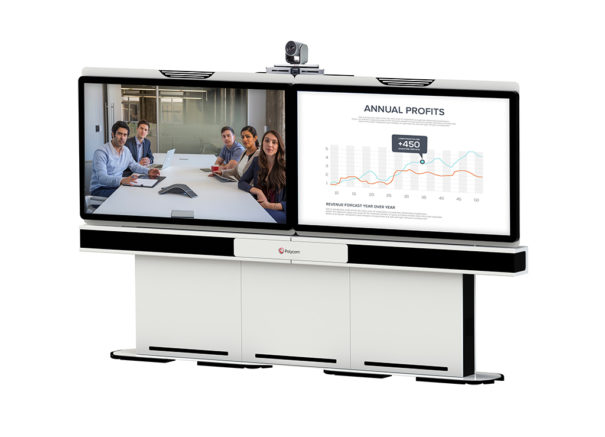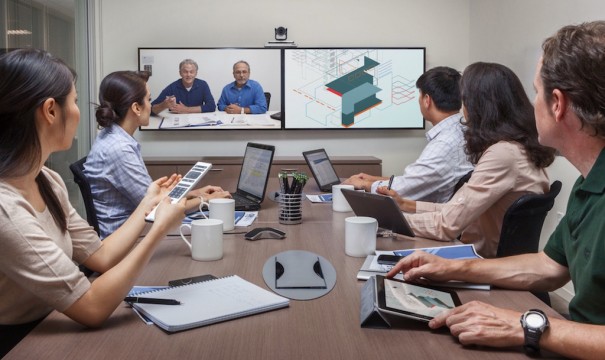WebRTC como estándar para impulsar la comunicación empresarial por vídeo
Cada vez más soluciones de vídeo utilizan este sistema basado en navegador en tiempo real para realizar videconferencias de manera sencilla y rápida, tal y como explica en este artículo Andrew Hug, vicepresidente de ingeniería de sistemas en Polycom EMEA, aportando aplicaciones reales en entornos corporativos.
 Si bien WebRTC o Web Real Time Communications es conocido desde hace tiempo, los estándares y recomendaciones que se aplican son ya suficientemente maduros para respaldar el desarrollo activo de sus aplicaciones e interoperabilidad, y todavía tienen que llegar a un punto en el que comience a ofrecer una diferencia real en la forma en que las personas utilizan el vídeo para comunicarse entre sí y con las empresas con las que se relacionan.
Si bien WebRTC o Web Real Time Communications es conocido desde hace tiempo, los estándares y recomendaciones que se aplican son ya suficientemente maduros para respaldar el desarrollo activo de sus aplicaciones e interoperabilidad, y todavía tienen que llegar a un punto en el que comience a ofrecer una diferencia real en la forma en que las personas utilizan el vídeo para comunicarse entre sí y con las empresas con las que se relacionan.
El estándar habilita las comunicaciones por vídeo basadas en navegador en tiempo real y mejora la capacidad de realizar videoconferencias, haciéndolas tan sencillas como una llamada de teléfono. Las reuniones a través del vídeo son posibles con un navegador compatible con WebRTC, que no requiere que los usuarios descarguen ningún complemento de software o plugin.
Existen ya soluciones de vídeo que usan WebRTC como Google Hangouts, y los principales navegadores del mercado lo admiten, como Opera, Google Chrome, Mozilla Firefox, Safari y Microsoft, que ahora proporciona soporte al estándar con ORTC (Object real time communications).
Solución para empresas
No doubt, el sistema de videoconferencia independiente del navegador de Internet y de plugins es el camino a seguir, ya que facilita su integración en otras soluciones, es más seguro y crea nuevas oportunidades en el área de las comunicaciones B2C. A pesar de que los flujos de audio y vídeo de WebRTC están codificados, los usuarios tienen que confiar en las soluciones de Comunicaciones Unificadas (CU) que proporcionan las empresas para conectarse y tener seguridad transversal continua.
Otro sector que será testigo de una alta adopción de este método de comunicación de vídeo es el comercio electrónico. Ejemplo de ello es el de una oficina italiana de alquiler de coches donde cada mostrador estaba equipado con un equipo de videoconferencia para poder interactuar con el personal ubicado en otros lugares para alquilar un coche, junto con un escáner e impresora para los documentos.
 The same, en la asistencia sanitaria hay oportunidades obvias para mejorar las consultas a través de vídeo y que sea más fácil para los pacientes realizar consultas desde sus propios hogares. Una revisión visual preliminar del estado o la gravedad de una lesión es esencial para proporcionar asesoramiento sobre posibles tratamientos. In addition, el vídeo ya se utiliza internamente entre hospitales para que los expertos puedan ayudar en casos de emergencia donde no pueden estar físicamente los profesionales presentes.
The same, en la asistencia sanitaria hay oportunidades obvias para mejorar las consultas a través de vídeo y que sea más fácil para los pacientes realizar consultas desde sus propios hogares. Una revisión visual preliminar del estado o la gravedad de una lesión es esencial para proporcionar asesoramiento sobre posibles tratamientos. In addition, el vídeo ya se utiliza internamente entre hospitales para que los expertos puedan ayudar en casos de emergencia donde no pueden estar físicamente los profesionales presentes.
También en el sector financiero hay grandes ventajas asociadas con la posibilidad de conectarse a través de vídeo. For example, las personas con grandes patrimonios o HNW (high net worth) a menudo se inscriben en el servicio de banca Premium, que les permite conectarse directamente con un empleado del equipo bancario.
WebRTC tendrá un impacto significativo en la forma en que las empresas integrarán la videoconferencia en sus flujos de trabajo. No sólo mejorará la velocidad y la calidad de los procesos de toma de decisiones, sino que también cambiará nuestra forma de trabajar en el futuro. Todos los proveedores relevantes de soluciones de videoconferencia empresarial ven un futuro positivo en WebRTC y la mayoría ya han adaptado su portfolio para trabajar sin problemas con él.
For example, la solución RealPresence Web Suite de Polycom utiliza WebRTC para conectar a usuarios que podrían estar ubicados en diferentes lugares y utilizar distintos tipos de dispositivos. In the coming years, el uso de WebRTC se basará principalmente en proyectos piloto y planes de desarrollo lanzados para crear aplicaciones profesionales basadas en este estándar, de manera que las empresas tendrán la oportunidad de identificar y probar las aplicaciones profesionales que se desarrollen.
Andrew Hug
Vicepresidente de ingeniería de sistemas en Polycom EMEA
You liked this article?
Subscribe to our Feed And you won't miss a thing.














